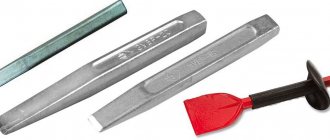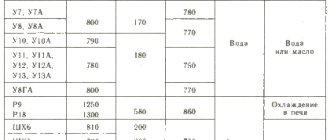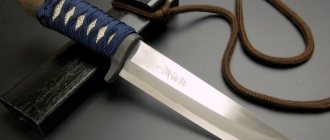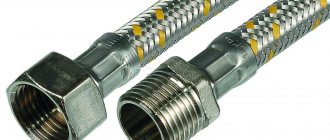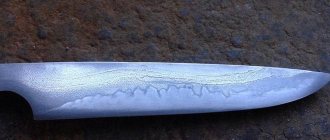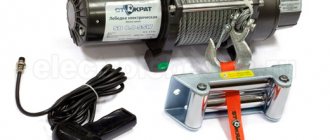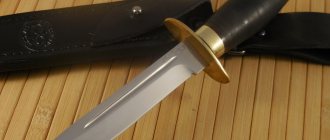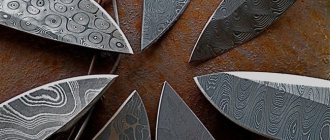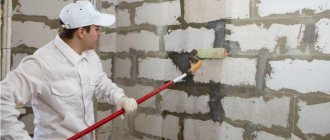What is more important for a hunter - a knife or a gun? Most likely, many will answer that it is a gun. Well, okay, so you got an elk or a wild boar, and then what? Will you put him on your back and go home, and then let your wife butcher him? - such an action would be worthy of being captured in a painting - “The last day of a hunter or a bad hunter is a problem in the family.” But, perhaps, let’s leave this humorous note and look into this issue seriously.
In fact, not a single hunter can give an exact answer what is more important for him - a knife or a gun, since without these two attributes hunting as such is not possible. Here I would like to immediately note that we are talking about real hunters, and not about those individuals who are brought to shoot the animal, and then also butcher it for them. It’s dangerous to give such types a knife in their hands; they’ll cut themselves again. But for a real hunter, a knife is not just an object, it is a friend and helper, starting from kitchen and household work in the camp, ending with harvesting (finishing off) and cutting up the hunted animal.
Purpose of hunting knives
A hunting knife is used for specific purposes and tasks. In accordance with this, restrictions are placed on the blade in the form of size, sharpening and profile. And it should be taken into account that several products are often used for hunting, it’s more convenient.
These knives differ in their purpose and blade shape. It is rare to find a universal product that will combine these qualities. Let's look at the three main hunter's knives that are best to have with you on a real hunt:
- Skinner . The blade has a rounded or blunt tip, often with a skinning hook on the butt. When cutting, this form of the product will not allow the animal’s skin to be damaged. The knife is not used for all types of hunting, but it is very convenient to remove skin;
- Hunting knife . A simple straight blade profile with sufficient length for a possible addition to the beast. The knife does not have various frills in the form of curvatures, notches or thorns. This will interfere with their ability to perform various manipulations. Large tactical products are not suitable as a hunting product;
- Dobornik . These are often dagger-shaped blades of quite large sizes. Such a product should be convenient for picking up wounded animals, and accordingly the length should be rather large. The knife is not used in all types of hunting, but when working with large animals, it is often simply necessary.
Expert opinion
Konstantin
Since childhood, I have been interested in knives and everything connected with them. I bring the accumulated knowledge to the masses. I make knives myself. I take criticism positively, but I also like to argue.
I would like to say separately about folding knives. No matter how the manufacturer advertises them, believe me, a rare lock can withstand a direct piercing blow. Also, grease, dirt and blood will constantly clog in the cavity of the mechanism, and it will not be possible to get them out without disassembling the product. And this is fraught with pockets of corrosion and an unpleasant odor.
Sharpening knives
Over time, even the highest quality steel becomes dull. In this regard, the blade needs periodic sharpening. The approach to this operation is largely determined by the shape of the blade. It is most convenient to work with a shape in the form of a double wedge with uniform bevels of the blade on both sides. This type of knife is suitable for any operation and is the easiest to sharpen.
When performing work, it is important to maintain the original sharpening angle. The smaller it is, the more filigree work can be done with a knife. For delicate operations, blades sharpened at 9–16 degrees are suitable. A 20-degree sharpening is considered universal. For rough operations you will need an angle of up to 30 degrees.
Sharpening is carried out using a sharpening stone with a not very rough surface. Typically, 20-centimeter flat and wide stones are used for this. Before starting work, they are moistened with oil (vegetable or even technical oil will do). If there is no oil, you can use a soap solution.
The blade is positioned at the required angle. Next, with decent pressure, they begin to move the knife towards themselves on the stone. 5-6 movements are enough, after which the blade is turned over and the same amount of friction is performed on the stone again.
A shiny stripe will appear along the entire length of the metal being sharpened. It should be the same width across the entire blade. If the blade is not sharp enough the first time, the work is repeated. However, this time they put in a little less effort. For the second sharpening, it is recommended to use a stone with a fine-grained structure.
The final operation is to correct minor defects in the metal surface and polish the pointed area. A properly sharpened blade of a hunting knife should cut a sheet of newspaper without any effort.
Special devices are used to sharpen difficult-to-grind blades. On a horizontal board, ceramic sharpening sticks are installed in the holes provided for this purpose. With their help, you set the desired sharpening direction. Blade movements go from top to bottom.
What is better, a bladed weapon or a regular knife?
An article on our website will help you identify edged weapons. It is determined by a number of specific characteristics. But edged weapons and household products may often not differ much from each other.
Therefore, you need to consider whether you should pursue minor advantages. But at the same time, various restrictions are imposed on you, such as a ban on wearing it outside hunting grounds and difficulties with purchasing and storing the product.
In fact, these are echoes of the past, when the circulation of any blades other than kitchen blades was under the control of law enforcement officers. In most cases, almost any bladed weapon has a copy within the limits of the law. An example would be a sophisticated butt.
Hunter knives.
Attention to the blade
Don’t chase a high price, choose a steel that you don’t mind spending money on. In order to cut up a chicken once a year, it is not necessary to buy a combat blade or a handmade product made of damask steel or Damascus steel.
In general, you should choose steel for hunting knives based on the area of use. Take into account your laziness, even if the steel grade of the knife is the best, it will quickly deteriorate and become corroded from lack of care.
Remember, even the sharpest knife will eventually become dull and will have to be sharpened. There is no such thing as an eternal sharpening that will last for years with constant use.
Requirements for hunting knife steel
It should be noted that the hunting knife could always cut well. Steel grades mainly differ in the percentage of carbon they contain. But it is important to maintain the right balance of other supplements. With increased carbon content, products become brittle and easily rust.
Metal hardness
The hardness of an alloy can essentially be defined as its ability to penetrate another material. This parameter is usually measured using the Rockwell scale (HRC). The higher it is, the harder the steel.
This parameter is affected by the carbon content in the alloy.
A product with high hardness retains its sharpness longer. But at the same time the blade acquires a certain fragility. The knife can be broken or splintered. It should also be taken into account that the harder the steel, the more difficult it is to sharpen. To do this, you may need special stones or a machine.
Hunting products.
Strength
Strength and hardness are two mutually exclusive parameters. When choosing a durable product, you will certainly lose in hardness. And it should be taken into account that the higher the hardness, the lower the strength of the product. This is the whole point of choosing the optimal metal for a hunting knife.
Durable steel will never chip. As a result of lateral loads, a durable blade will never break - it will bend. High carbon steels are hard and prone to brittleness. It is also prone to the appearance of pockets of corrosion.
Corrosion resistance
This parameter makes it possible to use the blade in wet conditions. Please note that a hunting knife is often used in wet weather. The blade of the product comes into contact with water and blood. Steel, which has poor corrosion resistance, is not suitable in this case, as performance characteristics are lost.
Hunter knives.
Alloying Additives
To obtain certain properties of a metal, various chemical elements are added to it during manufacturing. The most popular impurities are:
- chromium. Increases the strength of the alloy and improves its resistance to corrosion;
- vanadium. Increases wear resistance, strength and enhances resistance to mechanical loads;
- manganese. Thanks to this element, you can create a blade of any shape. The steel becomes malleable when forged;
- nickel. Gives the alloy the same qualities as chromium, but much more pronounced;
- tungsten. Helps resist corrosion and makes the blade scratch-resistant;
- molybdenum. Makes it possible to use the blade under extreme conditions;
- silicon. Improves the malleability of steel, acts like manganese.
Do you love hunting?
Very! No...
Hunting knife steel
To make a quality hunting knife, good steel is required. It should be taken into account that the blade will be exposed to water and blood. For this reason, it is better to choose a stainless alloy. For most models, high-carbon steel is chosen.
It provides good hardness to the metal. But at the same time, it is necessary to include other chemical elements in various proportions. Which will give the alloy corrosion resistance, wear resistance, strength, toughness and resistance to mechanical loads.
A hunting knife with high hardness will be difficult to sharpen. But soft alloys that can be sharpened on any stone should also not be used. In this case, you should look for a middle ground. There is a special criterion for assessing optimal hardness.
It consists of skinning and butchering one deer without sharpening. The manufacturer almost always puts the grade of steel used on a hunting knife. This information can also be found in the certificate that comes with the product.
A few more hunter's items.
Popular brands
There are steel grades that are very different in composition and characteristics, used in knife production. It’s easy for an expert to make a choice; he definitely sees the tasks for which the product is being created. It is quite difficult for someone with little knowledge of these matters to select the necessary brand. Below are the most famous brands of Russian steel found on the market:
420
This is a relatively inexpensive alloy for the production of blades, with a carbon content of 0.5%. It can be sharpened without much effort, it is characterized by good resistance to corrosion processes and a long service life.
Knife with blade made of 420 steel.
440A
The steel comes from America and has good corrosion resistance. Hardens to 56 HRC. Mainly used to create inexpensive models. A very good alloy for everyday use.
Steel 440A.
440B
Similar in performance to 420A. Analogues are the following steels: 95x18, AUS-8, 1.4112.
Knife with blade made of 440B steel.
440C
It is considered the best alloy of the 420 series. Blades from it are of slightly better quality, but the price of this alloy is an order of magnitude higher than its counterparts. It is a wear-resistant and hard metal.
Knife made of 440C steel.
AUS-4
Country of origin: Japan. It is used relatively rarely for knives; cheap serial folding and kitchen samples are made from it.
Knife made of AUS-4 steel.
AUS-6
The average hardening rate is 55-57 units. The alloy is classified as analogous to 440A.
Knife with AUS-6 blade.
AUS-8
The Japanese brand combines a balance between resistance to wear and corrosion processes. It is widely known in knifemaking due to its properties and low cost. Typically hardening reaches 58 HRC.
Steel marking AUS-8 on the Zlatoust knife.
AUS-10
Japanese steel grade, analogous to 440C, ideally meeting all the requirements for creating high-quality blades. It has been very popular for many years.
Japanese kitchen knife made of AUS-10 steel.
N-1
Chromium-nickel steel holds factory sharpening for a long time and withstands even harsh use. The hardness of the metal is within the range of 58-60 HRC.
Blade made of N-1 steel.
Inox
The alloy has a good rust resistance coefficient. Demonstrates itself perfectly in everyday use. The alloy is hardened to 56 HRC. It is mainly used to produce combat models, knives for diving, and hunting.
Folding knife Opinel 12, Inox steel.
Domestic knife steels
The hunter's knife is used in extremely unfavorable conditions. Not every steel can withstand such treatment. In hunting conditions, it is not always possible to provide proper care to the metal of the blade. For this reason, you should choose steel that can withstand such loads. Among Russian alloys, there are metals with good properties.
Steel
After the buyer has figured out the geometry of the blade, the handle and other nuances, he needs to pay attention to the steel. This, of course, is not a primary factor, but still far from unimportant. The most beautiful knife in the world, if we consider the blade, is a product made of Damascus steel. Made from a bunch of metal rods, it ultimately creates numerous iridescences on the blade.
Characteristics
There are many different metals. They can be used to create homemade hunting knives and professional products. It is believed that the most durable knife is made from high-carbon raw materials. It doesn’t matter what will be made from it – a hunting dagger or a drop point, if it’s done well, it will last a long time.
In order to decide which steel is best for a hunting knife, you need to know its types and methods of manufacturing the product. For example, Damascus and damask steel are durable and high-quality, but quite expensive. It is much easier to buy cheaper and almost the same parameters steel of a simple sample. Although it is worth repeating that the most beautiful knife can be made from these two expensive options.
For a beginner, it is enough to know two high-quality types that are widely popular all over the world. A hunting dagger, like any other blade, will be of the same quality.
Х12МВ
The best steel for a hunting blade in the hands of a beginner is X12MB. It has a high density, resists corrosion well, is quite viscous, and has excellent temperature resistance. It makes a durable product that makes it easy to skin the carcass. It also makes excellent forged hunting knives.
An important factor in hunting conditions will be the long “life” of the sharpening of this tool. Tools made from this steel are perfect for long-term use in extreme conditions.
ХВ5
This carbon steel has a diamond additive. This adds hardness to it, which improves the cutting function of the product. When deciding which knife to choose, you should pay attention to this type of raw material. It is of high quality and will allow the tool to last for a very long time and, at the same time, there will be no need to sharpen it often.
However, steel knives of this type have one drawback. Steel can quickly corrode if the blade is not cleaned and maintained after each use.
Foreign knife steels
When purchasing a blade for hunting, you should carry a small amount. Because in this case, a lot depends on the financial capabilities of the future hunter. It can be very difficult to choose a knife from all the abundance of products and some can be expensive. Let's look at imported steels, but their cost is not a budget option.
Leading manufacturing companies
Among the leaders according to various ratings of specialists are such Western companies as Solingen from Germany, Wenger from Switzerland, Vinkinson from Britain. There are many other manufacturers (mostly Japanese, Americans and Germans), but the mentioned trio is the absolute champion in terms of the level of products produced and the popularity of brand names.
Among Russian companies, the samples from the Kizlyar and Zlatoust arms factories are most famous. They create products of decent reliability at an affordable price.
Damascus steel
Modern Damascus has little in common with ancient products, because the real secret of production has been lost.
Ancient Damascus was used to make blades in India. But today it can be found in museum exhibits or private collections. Today, Damascus is made by repeatedly forging a package of steel in several layers. The hardness of the alloy can reach 60 HRC. And on the blade of the product you get a beautiful design. A lot of manufacturers make knives from Damascus.
But they are especially good from Dagestan masters from the city of Kizlyar. Damascus products have high cutting performance. But they cannot be left wet, otherwise the steel will begin to rust. Steel knives require constant care.
If pockets of corrosion appear, they are removed by polishing. And when storing the product for a long time, it should be coated with a small layer of gun oil. Damascus knives cost a lot due to the complexity of production.
Damascus steel knives.
Useful tips
Main recommendations for using and storing knives:
- each knife must be lubricated, both fixed and folding knives (for folding knives, it is necessary to lubricate not only the blade, but also the lock structure and similarly moving parts);
- make sure that the knives have working sharpness (a sharp knife, contrary to the stereotype, is much safer to use than a dull one);
- after completion of use, the blade must be rinsed and wiped dry; the blade should not be left wet;
- folding knives have a more complex design than those with fixed blades; therefore, they require more scrupulous care, constant cleaning of dust and lubrication;
- Without possessing at least basic skills, there is no need to attempt to restore a damaged knife, especially a folding knife. Thus, you can get injured or permanently damage the cutting tool.
Rules for storing and carrying knives
A real hunter must handle his working tool carefully so as not to damage his equipment or himself.
Knife in a leather sheath for storage.
A high-quality knife almost always comes with a sheath, the so-called sheath. It is made from various materials. Leather and plastic are especially in demand.
Leather sheaths are more comfortable to use. The leather is strong and has very little weight. Fine leather is used to produce sheaths. The material is impregnated with a special waterproofing composition to resist moisture and maintain its original appearance.
The appearance of such sheaths is traditional - the blade fits tightly into them up to the handle.
The leather case must not be washed, otherwise it will quickly become unusable. If the case gets wet, it must be dried immediately, wiped off dirt and applied to it with a skin composition; a simple hand or face cream will also do.
Advice! In intervals between intensive use, it is advisable to store the knife separately from the leather sheath. This will make it possible to protect steel from the negative effects of tannins present in the leather.
Bulat steel
The surface of the blade of damask steel has a pattern similar to Damascus, but these alloys should not be confused. The secret of producing real damask steel was also lost, but in the 1830s a method for producing Russian damask steel was invented.
This steel was produced at a plant in Zlatoust under the leadership of metallurgical engineer P.P. Anosova. In the modern world it is often called Anosov steel. But modern products do not exactly repeat the recipe of Zlatoust production.
The fact is that this production method was partially lost. Today, damask steel knives have high hardness and good flexibility. But in comparison with products from the past, they are slightly inferior in various respects.
Damask steel products.
About damask steel
Like Damascus steel, damask steel has a unique internal structure and differs from other brands in its original appearance. This material is iron with a high carbon content. According to experts, damask steel is not inferior to cast iron in terms of the amount of carbon. At the same time, unlike cast iron, due to its special structure it is highly flexible. There is a misconception among consumers that damask steel is the most advanced steel and is used to produce the best hunting knives.
As experts say, such a belief is very far from reality. If you compare damask steel with “regular” steel grades, it becomes clear that their performance characteristics are practically the same. In fact, damask steel is interesting primarily because of its unusual and very impressive appearance. Souvenir blades are mainly made from this material.
Sharpening angle
The working properties of a knife are determined by the correct sharpening angle. Sooner or later the knife will have to be sharpened. But many people don't know how to do it correctly. If the process is carried out incorrectly, the blade may lose its factory sharpening, and it will be very difficult to restore it.
The cutting edge of the knife is sharpened. This narrow strip should be straight on both sides. The smaller the angle formed at the cutting edge, the sharper the blade will be. But the knife will also become dull faster. The optimal sharpening angle for a hunting knife is considered to be 30-45 degrees.
The sharpening angle is determined for both sides, which means that on each side it should be around 15-20 degrees. When sharpened in this way, the knife will not be razor-sharp, but it will not become dull during prolonged use.
Knife sharpening angle.
Hunting knife length
The optimal length of the blade can be called 8-12 cm, it will be approximately equal to the length of the handle. This product has good balance and fits comfortably in the hand.
A knife with a center of gravity in the front of the handle is most convenient for cutting.
But with a short blade it will be difficult to cut off a branch if necessary or perform other tasks. For chopping manipulations, a blade with a length of 15-20 cm is convenient. Products with large sizes can hardly be called a hunting knife; it will be more like a machete or a cleaver.
Butt thickness
Hunting products with a butt thickness of up to 2.5 mm are very convenient for working in a field kitchen. These blades are convenient for peeling vegetables, cutting potatoes, and removing fillets from fish. But for serious work you need a blade with a thicker spine.
Most universal hunting knives have a thickness of 2.5 to 5 mm. The blade can be used for cooking, but can also be used for more serious work. This product can be used to cut branches for a hut and butcher game.
Knife care
A hunting knife, like any other equipment, requires special care and storage. If you take care of the product, it will last much longer. The following rules must be followed:
- after washing the knife, it should always be wiped dry with a cloth;
- to avoid corrosion before storing the product, the blade is coated with a thin layer of gun oil;
- The blade should be stored in a sheath or in a special case;
- After using the knife, you should always rinse it with water and remove all dirt;
- It is better not to wash the blade sheath with water, but to wipe it with a dry cloth and dry it;
- the handle must be treated with special oils to prevent cracking;
- It is not recommended to perform actions with a knife for which it is not intended.
Rules for storing and carrying knives
The hunter must treat his blade with care to ensure it is carried safely and to protect the metal blade from physical damage.
A good knife comes with a case called a sheath. The case is made from different materials. The most popular are leather and metal.
From a practical point of view, a leather sheath is convenient. They are worn on the belt or under the arm. At the same time, leather is durable and weighs much less than metal. To make a sheath, fine leather is used and stitched with thick thread. The material must be impregnated with a special moisture-proof compound.
The design of leather sheaths for hunting knives is standard - the blade goes into them all the way to the handle. Thanks to the belt ring, a belt is threaded into the sheath. There is a strap at the top with a fastening mechanism to securely fix the handle. If the sheath is intended to be placed on a belt, it is equipped with a belt ring or a special hole.
Leather sheaths cannot be washed, otherwise they will deteriorate. If the material gets wet, it needs to be dried, cleaned and soaked in a special composition for leather. If there is none, a regular human skin care cream will do.
Advice! In between seasons, it is recommended to keep the blade separate from the leather sheath. This will protect the metal from the negative effects of tannins present in the leather.
There are also sheath models where the knife is completely hidden in it along with the handle. We are talking about Western manufacturers. For example, there are plenty of such sheaths in the Buck company’s assortment.
The blade in the sheath must be dry and clean. If the sheath is made of metal, it is necessary to wash it with water after hunting and then wipe it thoroughly. It is also recommended to lubricate metal surfaces with wax.
Hunting steel knives
There are many types of hunting knives. They may differ in various parameters. But the most important characteristic is the steel on the blade of the product. This determines what functions can be performed with a knife. Let's look at a few examples of excellent knives made from various grades of steel.
Knife – Hunter Small
The small hunter knife was developed by Australian knife designer Julius Conrad, who began working at PP Kizlyar LLC in 2006. The “Hunter M” was based on traditional German hunting knives and it was designed based on them. When developing the Hunter M, Julius sought to create a reliable and durable knife with maximum versatility. Blade characteristics:
- Total length: 225 mm;
- Blade length: 105 mm;
- Blade material: AUS-8;
- Butt thickness: 3 mm;
- Handle material: Wood;
- Manufacturer: Kizlyar, Russia;
- Weight: 165 grams.
A reliable and strong knife with maximum versatility.
Knife AiR – Trapper small
Trapper is a convenient hunting knife made in the style of traditional Canadian trapper knives (fur hunter knives). This knife will come in handy when hunting and camping, when performing everyday household tasks: cutting meat, meat products, vegetables, fruits, etc. The design feature of the Trapper is a teardrop-shaped blade, which is quite effective in both cutting and thrusting. Knife characteristics:
- Total length: 225 mm;
- Blade length: 100 mm;
- Butt thickness: 2.4 mm;
- Blade material: 95Х18;
- Handle material: Wood;
- Manufacturer: AiR, Russia;
- Weight: 130 grams.
The blade is quite effective in cutting.
Knife – Southern Cross FOX
This is a universal hunting knife, also suitable for tourism. It has a fairly powerful blade and lens-shaped triggers. It has excellent cutting properties and a comfortable micarta handle. This is a structural composite material, which is a layered plastic based on fabric and a polymer binder. Product characteristics:
- Knife length: 250 mm;
- Blade length: 133 mm;
- Handle length: 117 mm;
- Blade width: 30 mm;
- Butt thickness: 3.5 mm;
- Blade material: D2;
- Handle material: Micarta;
- Weight: 188 grams.
The blade is useful when performing everyday household tasks.
How to choose a knife for hunting
So, we have dealt with the main mistakes when choosing a knife for hunting. Now let's look at several worthy examples of knives that are perfect for hunting, and using their example, we will understand the nuances of the right choice, based on their tactical and technical characteristics. We will consider according to the following criteria:
- Blade length
- Blade shape
- Knife balance
- Steel
- Installation (handle shape and material)
- Sheath
How to choose this parameter correctly? After all, it is convenient to butcher a hunted animal with a small and nimble knife, with a blade length of 8 to 12 cm. But at the same time, such a knife will no longer be convenient for doing hard work, for example, setting up a temporary storage shed or parking lot. For such purposes, you need a large knife with a blade length of 16 centimeters, a thick spine of 4 millimeters, and at the same time the correct geometry, which would allow it to effectively stab, chop, butcher a large animal, but at the same time remain a knife that can cut perfectly.
Knife “Lin” 38033 Kizlyar 1,840 for 1 piece. Knife “Owl” 39633 Kizlyar 2,400 for 1 piece. Knife “Finnish” 33736 Kizlyar for 1 piece. Knife “Finnish” 33733 Kizlyar 2,375 for 1 piece. Cutting knife “Filin” 011305/011305 Kizlyar 2,560 for 1 piece. Skinning knife 95X18 (Lemax) Lemax 2,965 for 1 piece. Knife “Wanderer” 35336 Kizlyar 2,330 for 1 piece. Cutting knife “Sh-5 Bars” 011461/015461 Kizlyar for 1 pc. Knife “Shark-2” engraving 50631 Kizlyar 3,775 for 1 piece. Yakut knife “large”, steel X12MF, wenge, wooden sheath Semin 10,240 for 1 piece.
Go to the knife catalog
And from the above, we understand that in order to effectively complete the assigned tasks, a hunter needs to have two knives! And this has been used for a long time. For example, reindeer herders and hunters of the Finno-Ugric peoples of Northern Europe, from the 17th century to the present day, effectively use two knives: one is small with a blade length of 8-10 centimeters (Finnish - puukko) for fine work, the other is a large cleaver with a blade from 16 centimeters or more (Finnish – Leuku) for heavy work. As we see, it was invented by real harsh northern hunters and reindeer herders, for whom hunting and cattle breeding were a way of life and a means of subsistence, and not a hobby. You and I also don’t live in Cyprus, and our climate is no less harsh, so let’s find our own match.
Small knife "Kuzyuk"
As one of the options for the role of a small knife, the “Kuzyuk” model from the domestic company AIR in the city of Zlatoust is perfect.
Blade length
Its small blade, 10 centimeters long, will perfectly cope with various tasks, from preparing field stew to cutting up hunted animals. Of course, if the hunter’s experience allows him to do this along the joints and between the vertebrae.
Blade shape and geometry
The shape of the blade and its geometry are made in the traditional Scandinavian style. This means that the knife has fairly low chisel descents to zero, only the chisel has a descent on one side, while Scandinavian-type blades have a descent on both sides. This is done so that the blade does not move to the side when cutting, but at the same time the knife retains simply first-class cutting on wood, meat, poultry and fish, it easily falls apart without noticing resistance. Another advantage is that it is easy to sharpen; the knife rests with the entire slope on the stone, thereby easily controlling the angle. But the “walking” of the angle is the primary problem for beginners when sharpening a knife; with a similar geometry it fades into the background.
As for the disadvantages of such geometry, I think there are none. If knives with a Scandinavian blade structure were created for the kitchen, they would be simply terrible in this role. Since, due to their low slopes, they simply split vegetables like cleavers. You can somehow cut the same carrot, but you can’t cut it thinly.
But such geometry is not for urban cuisine, but for forests, taiga, tundra, so it has no disadvantages. But no one will delicately cut potatoes in the field.
Knife balance
The balance of the knife is correct, it is slightly offset into the handle and this is absolutely correct. After all, with such a small size, the knife is clearly not intended for chopping, which means there is no point in shifting the balance to the blade. But when moved into the handle, it doubles the control of the knife during delicate work, allowing you to do truly fantastic things.
Steel
Of course, steel also contributes to this. I can’t say that it is ultra-modern, but the piece of hardware has proven itself to be an excellent worker in the middle price segment. 95X18 is a stainless steel, quite tough, which allows it to withstand excessive loads. That is, if something happens, the knife will get a jammed cutting edge instead of a chip. And it sharpens easily, which is important in field conditions. We can also add that AIR became famous for its good heat treatment of this steel. But if the user is sophisticated with modern “super” steels, then 95X18 will seem too simple and ineffective.
Installation, shape and material of the handle
Everything here is simple and classic. The wooden walnut handle has a barrel-shaped cross-section and, due to its simplicity, fits perfectly in the hand with various grips. And the absence of finger grooves makes it comfortable to hold in most palms. Of course, wood is more demanding to use than various synthetic materials, but with proper care (timely impregnation with various oils and waxes) it will last long enough to be inherited even by your grandchildren. The mounting of the blade in the handle (when the narrower part of the blade extends to a certain length of the handle) of course does not contribute to such colossal strength as that of the overhead mounting, but it is quite sufficient to perform most hunting tasks.
Sheath
The leather sheath is submersible type, that is, it does not have various straps or buttons for fixing the blade. Personally, I think this is a plus; this fixation system allows you to remove and remove the knife without removing mittens or gloves. It is very difficult to lose a knife; the fixation by crimping the handle with the mouth of the sheath and the free suspension of the sheath is quite reliable - even if you walk on your hands.
Large knife "Taiga"
Now let's pick up a big knife for heavy work. I also suggest considering the AIR company, since the knives are made in a recognizable style and will not only be functional, but also look like a set on a belt, and not a hodgepodge. Let’s, for example, focus on the “Taiga” model.
This is actually an excellent knife, well suited for both heavy work and capable of quite delicate slicing or chopping tasks. And all this thanks to thoughtful geometry. But let’s not be unfounded, and let’s look at all its pros and cons point by point.
Blade length
A seventeen-centimeter blade, well seasoned with a five-millimeter spine, is capable of confidently coping with the rough cutting of even a large animal. I can’t say that the length of the blade is ideal for cutting medium-sized trees, but judging by the shape of its handle and the rest of the geometry, the manufacturer did not intend this knife to be a replacement for an axe. But as a large cleaver, it will look great when cutting. And this is facilitated by its second parameter – descents.
Blade shape (geometry)
The slopes are straight almost from the butt, contributing to an excellent penetrating cut, even despite the impressive thickness of the blade, the knife is still capable of excellent cutting, but as I mentioned above, cutting down trees is not really its thing. I can’t say that it won’t be able to handle it, but thanks to the high straight slopes, which perform well when cutting, the knife will get stuck when deeply immersed in the wood.
Knife balance
Of course, it is shifted into the blade, which is correct; thanks to this, the knife is more comfortable to perform various chopping and power work. Naturally, this solution worsens control over the knife during delicate work, but we have a second small knife for these tasks.
Steel
The steel here is the same as on its smaller brother - 95X18. I can’t say that this solution is ideal for such a large knife, but given its extremely reasonable price, you can turn a blind eye to this. And its non-ideality, paradoxically, comes out of its advantages. The fact is that absolutely any stainless steel (95X18 does not rust at all) is not particularly well suited for chopping tasks. I will not go into detail about the influence of alloying elements on the mechanics of steel, but like any stainless steel, 95 lacks ductility under impact loads. This is not critical, but it is worth knowing.
Installation, shape and material of the handle
Classic mounted mounting, the shank runs along the entire length of the handle. As I already mentioned when considering a small knife, such installation is less reliable than a fultang (invoice). But, taking into account the experience of the northern peoples, and their large Leuku knives also had a mounted mounting, therefore the strength of the “Taiga” design is quite sufficient even for fishing tasks. As for the shape and material of the handle, everything is also classic. The cross-sectional shape is barrel-shaped and fits comfortably with different grips in most palms. On this example, the handle is made of hornbeam. The tree is popular for making knife handles; when dried well, it becomes harder than oak and is not susceptible to warping.
Sheath
Sheath "Taiga" submersible type, leather. It is worth noting that the leather is of good quality. Both rigid and free suspension are implemented - everything is strictly and according to the classics.
Small knife "Caribou"
Has it ever happened to you that when you see something you just fall in love with it? And unable to forget about her until she becomes yours. When I saw this knife for the first time in the picture, it did not evoke any emotions in me, but when I had a chance to hold it in my hands, I simply fell in love with this baby. This is Caribou, produced by Southern Cross.
I don’t know if the photo conveys all its beauty, but, as for me, it is simply the ideal of laconic forms and thoughtful functionality! But let’s leave emotions aside and analyze the knife point by point.
Blade length
This little reindeer “Caribou” is only 9 centimeters long, with a butt thickness of 3 millimeters. It may seem too short to some, but this length of the blade is quite enough for the second number in a pair. And the thickness of the butt is chosen ideally for its purpose and the geometry of the blade. Three millimeters is enough for high strength, but at the same time maintaining an excellent cut.
Blade shape (geometry)
The blade uses one of my favorite Convex geometries (convex lens to zero). There is always debate about what is better for hunting, Scandinavian lenses or a convex lens. These two wonderful geometries, very similar in functionality, work great on wood, meat, fish, poultry, but do not like dense vegetables, splitting them. I can also say purely subjectively that with the same steel, butt thickness and slope angle convergence, Convex is more durable under shock loads. Separately, I would like to note the shape of the blade; due to the rather large radius of rise of the cutting edge to the tip of the blade, the knife copes well with sanding the animal.
Knife balance
Of course, the balance is shifted to the handle, and more significantly than that of the Kuzyuk from AIR. If you open your palm with a knife clamped in it, it will still lie in it, and this is a very good quality for a small cutting knife.
Steel
In general, “Southern Cross” provides a good selection of steels, ranging from tool steels to various powder steels. This knife features N690 stainless steel from one of the world's leading suppliers of premium steels, the Austrian metallurgical company Böhler - Uddeholm AG. This piece of iron has proven itself well for outdoor knives due to its ability to adequately withstand impact and lateral loads, and good corrosion resistance. It takes a lot of effort to make this steel rust. But it is not 100% stainless, and requires at least minimal maintenance.
Knife Cedar steel D2 handle micarta blue notch Southern cross 8,725 for 1 pc. Knife Model XL steel N690 handle micarta coyote notch (Southern cross) Southern cross 9,230 for 1 piece. Knife Ratfix 120 steel D2 handle G10 black (Southern cross) Southern cross for 1 pc. Cariboo knife steel N690 handle micarta emerald cut Southern cross for 1 pc. Knife M1 steel N690 handle G10 red-black (Southern cross) Southern cross 7,200 for 1 piece. Cariboo knife steel N690 micarta handle yellow-green notch Southern cross 7,530 for 1 pc. Knife Cedar steel D2 handle micarta coyote notch (Southern cross) Southern cross 7,835 for 1 piece.
Catalog of knives “Southern Cross”
As for long cuts, the N690 is also quite up to par. I can’t say that this is her strong point, but as I wrote above, there are no universal steels; the emphasis is always shifted either towards long cuts, or towards good resistance to mechanical loads.
Installation, shape and material of the handle
Installation uses a consignment note - Fultang (English full tang - full shank). The most reliable of all existing options for attaching the handle. Perhaps this is even excessive for such a small knife, but there is no such thing as too much strength. Thanks to this mounting of the handle, this knife can be used even for heavy work. The shape of the handle is simple, which allows it to be manipulated with a variety of grips without experiencing any discomfort due to the anatomical protrusions. The handle itself is made of micarta, textured with a weapon's notch, the material is very tenacious and strong for various blows and falls, just what you need for a reliable friend.
Sheath
Very beautiful with their strict, laconic beauty. Cognac-colored leather of excellent quality, with high-quality processed ends, and a plastic liner inside the mouth of the sheath, which additionally protects them from cutting. A free and rigid suspension is implemented, there is a loop for attaching a flint, and a hole at the bottom of the sheath into which you can thread a cord and secure it around the hip.
